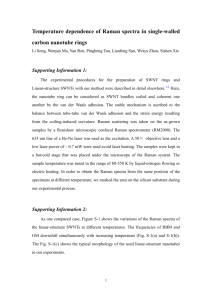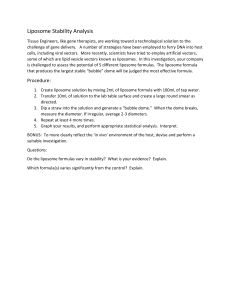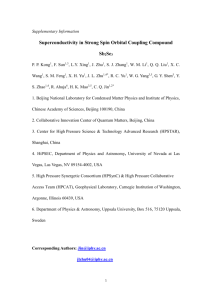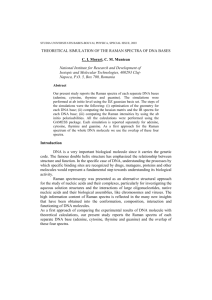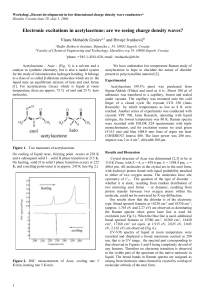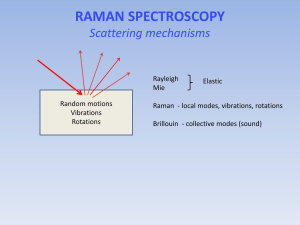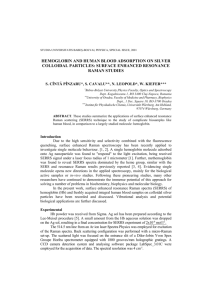Full experimental details and miscellaneous Raman spectra
advertisement
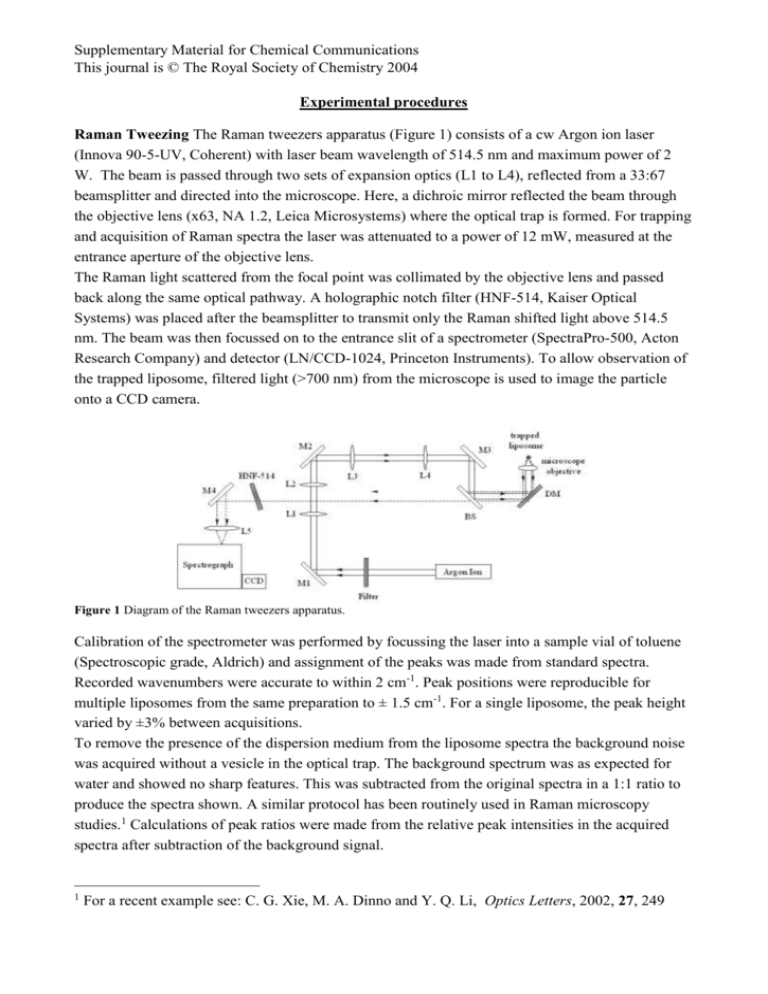
Supplementary Material for Chemical Communications This journal is © The Royal Society of Chemistry 2004 Experimental procedures Raman Tweezing The Raman tweezers apparatus (Figure 1) consists of a cw Argon ion laser (Innova 90-5-UV, Coherent) with laser beam wavelength of 514.5 nm and maximum power of 2 W. The beam is passed through two sets of expansion optics (L1 to L4), reflected from a 33:67 beamsplitter and directed into the microscope. Here, a dichroic mirror reflected the beam through the objective lens (x63, NA 1.2, Leica Microsystems) where the optical trap is formed. For trapping and acquisition of Raman spectra the laser was attenuated to a power of 12 mW, measured at the entrance aperture of the objective lens. The Raman light scattered from the focal point was collimated by the objective lens and passed back along the same optical pathway. A holographic notch filter (HNF-514, Kaiser Optical Systems) was placed after the beamsplitter to transmit only the Raman shifted light above 514.5 nm. The beam was then focussed on to the entrance slit of a spectrometer (SpectraPro-500, Acton Research Company) and detector (LN/CCD-1024, Princeton Instruments). To allow observation of the trapped liposome, filtered light (>700 nm) from the microscope is used to image the particle onto a CCD camera. Figure 1 Diagram of the Raman tweezers apparatus. Calibration of the spectrometer was performed by focussing the laser into a sample vial of toluene (Spectroscopic grade, Aldrich) and assignment of the peaks was made from standard spectra. Recorded wavenumbers were accurate to within 2 cm-1. Peak positions were reproducible for multiple liposomes from the same preparation to ± 1.5 cm-1. For a single liposome, the peak height varied by ±3% between acquisitions. To remove the presence of the dispersion medium from the liposome spectra the background noise was acquired without a vesicle in the optical trap. The background spectrum was as expected for water and showed no sharp features. This was subtracted from the original spectra in a 1:1 ratio to produce the spectra shown. A similar protocol has been routinely used in Raman microscopy studies.1 Calculations of peak ratios were made from the relative peak intensities in the acquired spectra after subtraction of the background signal. 1 For a recent example see: C. G. Xie, M. A. Dinno and Y. Q. Li, Optics Letters, 2002, 27, 249 Supplementary Material for Chemical Communications This journal is © The Royal Society of Chemistry 2004 Liposome Preparation Unilamellar liposomes were prepared by drying chloroform solutions (100 mg/ml) of the lipids in vacuo in a 50 ml round-bottomed flask to form a thin film. The dried lipid films were hydrated using phosphate buffered saline (pH 7.2, 1 ml per mg lipid)* and vortex mixed for 3 minutes. The lipid emulsions were then subjected to five freeze thaw cycles using liquid nitrogen and a water bath at 40 °C before being extruded ten times though a laser-etched polycarbonate membrane of pore size 2 m (Whatman). The final liposome preparations were diluted x10 for Raman tweezer experiments. For membrane partition assays, a solution (900 l) of the solute under examination was prepared in phosphate buffered saline. This was treated with 100 l of the liposome preparation to give a final liposome dilution of 1/10 and a solute concentration of 2.5% v/v. The mixture was incubated for 16 h before being subjected to analysis by Raman tweezing. * Phosphate buffered saline was obtained from Invitrogen and had the following composition: KCl (0.2 g/l), KH2PO4 (0.2 g/l), NaCl (8 g/l) and Na2HPO4 (1.15 g/l). Spectral Acquisition Raman scattering spectra were typically obtained from the trapped particle using a 150 s acquisition time at a laser power of 12 mW. The particle was dislodged and the process repeated to obtain the background spectrum. Both sets of data were filtered to remove signals due to cosmic radiation, and the corrected spectrum obtained by subtracting the background spectrum from that of the trapped particle. In the case of samples containing DMSO, cosmic filtering removed the sharp peak at 679 cm-1 arising from the sample, and consequently data was recorded with a 10 s acquisition time at a laser power of ~40 mW and processed without filtering. Supplementary Material for Chemical Communications This journal is © The Royal Society of Chemistry 2004 Miscellaneous Spectra Fig. 2 Raman spectra of A) 2.5% v/v DMSO/PBS (uncorrected); B) DMPC in PBS containing 2.5% v/v DMSO (corrected); C) the spectrum in (B) following subtraction of the standard DMPC spectrum. Fig. 3 Raman spectra of A) 2.5% v/v EtOH/PBS (uncorrected); B) DMPC in PBS containing 2.5% EtOH v/v (corrected); C) the spectrum in (B) following subtraction of the standard DMPC spectrum. Fig. 4 A) Magnitude of the Raman emission at 1440 cm-1 as a function of liposome diameter for DMPC liposomes in PBS; B) DOPC composition (mol%) of DOPC/DMPC liposomes as a function of size in a single sample population.




